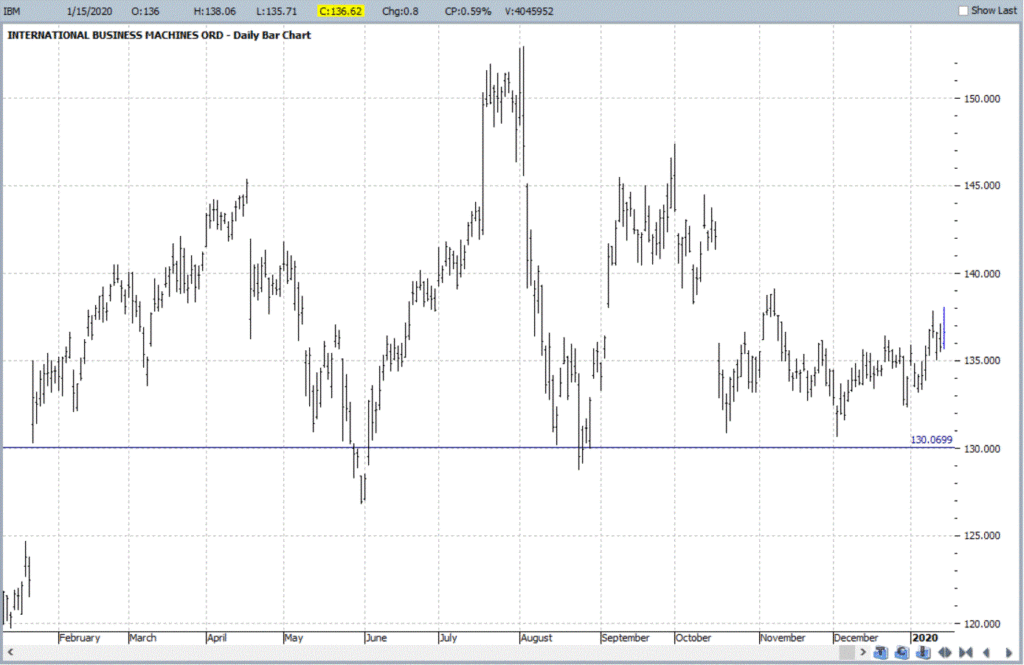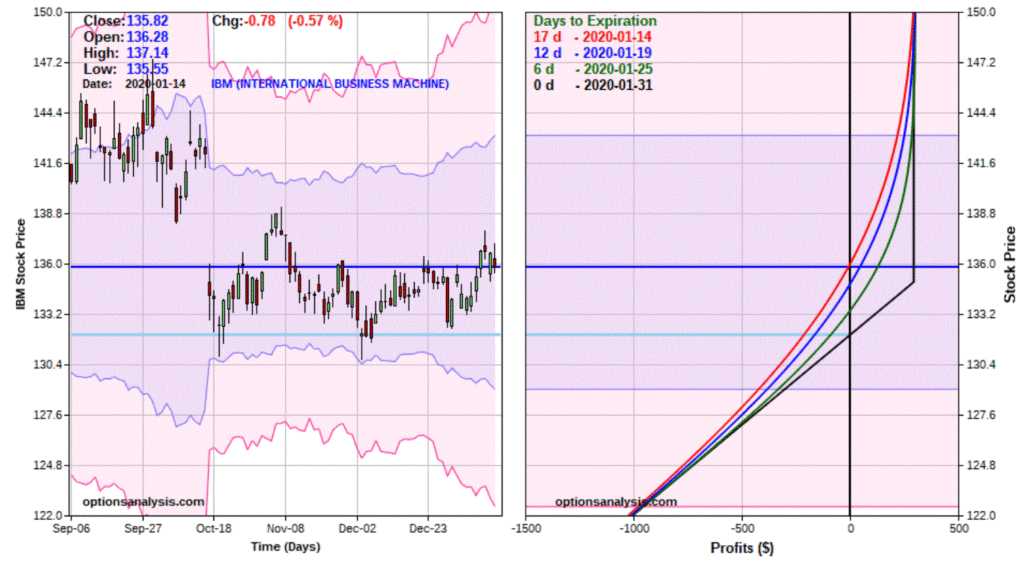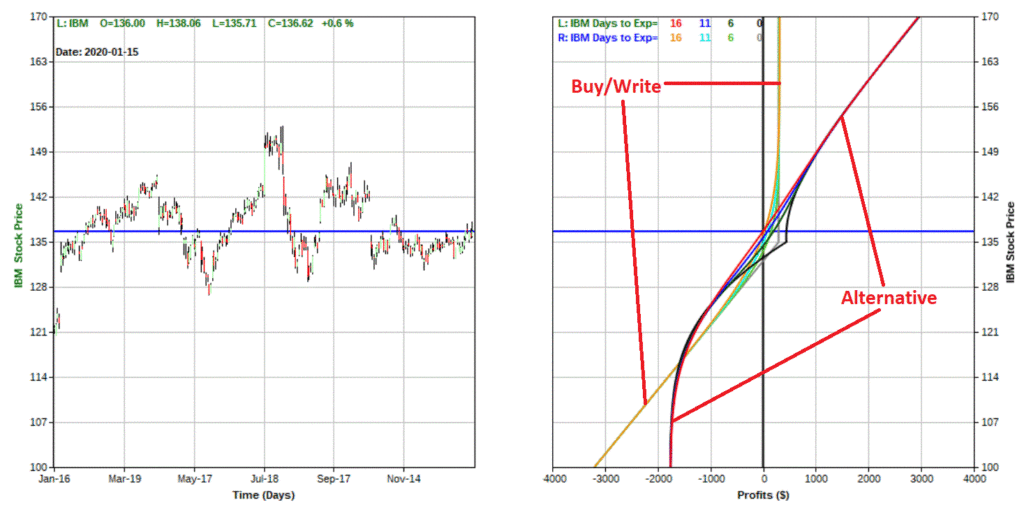The covered call writing strategy – i.e., writing a covered call against a stock you currently own in hopes of generating additional income – is a viable, as highly utilized strategy.
The “Buy/Write” strategy – i.e., where a trader buys shares of stock for the purpose of simultaneously selling a call option against it, is not one of my favorites.
IBM
In Figure 1 we see a recent low near $130 a share for IBM. So, we will look at two alternative trades with the idea that IBM will hold above this recent low (i.e., if price breaks below this level, loss cutting action will be required).

Figure 1 – IBM (Courtesy ProfitSource by HUBB)
What follows are two alternative positions. As always, please note that these ARE NOT recommendations, only examples.
An IBM Buy/Write
Figures 2 and 3 display the particulars and the risk curves for a standard issue “Buy/Write” that involves:
*Buying 100 shares of IBM at $135.82
*Selling 1 Jan31 135 strike price call.

Figure 2 – IBM Buy/Write details (Courtesy www.OptionsAnalysis.com)

Figure 3 – IBM risk curves (Courtesy www.OptionsAnalysis.com)
The problem with this position (as with any covered call position that writes 1 call option per every 100 shares of stock held) is that upside potential is limited while downside potential is not (which is why I always recommend that if you own 1,000 shares of stocks, sell 5 calls, or 7 calls, or 2 calls, or whatever, but NOT 10 calls, as selling 10 calls limits upside potential to strike price + call premium).
With IBM trading on 1/14 at $135.82 a share:
*This position costs $13,205 to enter
*Maximum profit potential is $295 (2.23%)
*If IBM shares are unchanged as of Jan31 option expiration the trade will gain $295
*The breakeven price is $132.05
*If IBM falls to $130 a share the position loses between -$347 and -$205, depending on whether $130 is hit sooner or later
So, you commit $13,205 to make $295 while essentially risking -$347 if you commit to exiting the trade if IBM drops to $130 a share.
An Alternative
As an alternative we will:
*Buy a lower strike price call option as an alternative to buying shares of stock
*We will buy one additional call option than we sell
Our position is as follows:
*Buy 3 Apr17 130 calls @ $8.38
*Sell 2 Jan31 135 calls @ $3.77
Figures 4 and 5 display the particulars for this position:

Figure 4 – IBM alternative details (Courtesy www.OptionsAnalysis.com)

Figure 5 – IBM alternative risk curves (Courtesy www.OptionsAnalysis.com)
This position costs $1,760 to enter (versus $13,205)
Maximum profit potential is theoretically unlimited as we hold one additional long call (versus a hard cap of $295 for the trade above)
If IBM shares are unchanged as of Jan31 option expiration the trade will gain roughly $343 (NOTE: this value could be higher or lower depending on whether the implied volatility of the long April calls rises or falls between now and Jan31)
The breakeven price is $132.31
If IBM falls to $130 a share the position loses between -$560 and -$435, depending on whether $130 is hit sooner or later
So, you commit $1,760 to make $343 (or more if IBM shares rise) while essentially risking -$560 (again, if you commit to exiting the position if IBM drops to $130 a share)
Assessing Risk and Planning Ahead
| Measure | Buy/Write | Alternative |
| Cost to Enter | $13,205 | $1,760 |
| Max Profit | $295 | Unlimited |
| Profit if IBM unchanged | $295 | $343 |
| Breakeven price | $132.05 | $132.31 |
| Loss if $130 hit today | (-$205) | (-$347) |
| Loss if $130 hit Jan31 | (-$435) | (-$560) |
Figure 6 – Comparison
Probably the best way to appreciate the trade off is to overlay the risk curves for both positions. See Figure 7 below.

Figure 7 – Risk curves for IBM Buy/Write vs. Alternative (Courtesy www.OptionsAnalysis.com)
Understanding what you are getting into is half the battle in option trading. We can sum up this comparison as follows:
If you are confident that IBM will hold above $130 a share between now and 1/31, the “Alternative” trade offers a lower cost of entry ($1,760 versus $13,205) and a higher profit potential than the Buy/Write.
HOWEVER, the “Alternative” trade – despite its lower cost of entry – entails a higher actual dollar risk if we are planning to use $130 as a stop-loss level.
Summary
Which is the better alternative? That’s not for me to say. Part of option trading success is developing the ability to assess alternatives based on one’s own personal reward/risk preferences.
Jay Kaeppel
Disclaimer: The information, opinions and ideas expressed herein are for informational and educational purposes only and are based on research conducted and presented solely by the author. The information presented does not represent the views of the author only and does not constitute a complete description of any investment service. In addition, nothing presented herein should be construed as investment advice, as an advertisement or offering of investment advisory services, or as an offer to sell or a solicitation to buy any security. The data presented herein were obtained from various third-party sources. While the data is believed to be reliable, no representation is made as to, and no responsibility, warranty or liability is accepted for the accuracy or completeness of such information. International investments are subject to additional risks such as currency fluctuations, political instability and the potential for illiquid markets. Past performance is no guarantee of future results. There is risk of loss in all trading. Back tested performance does not represent actual performance and should not be interpreted as an indication of such performance. Also, back tested performance results have certain inherent limitations and differs from actual performance because it is achieved with the benefit of hindsight.

